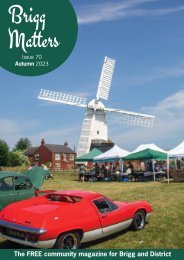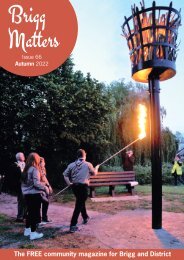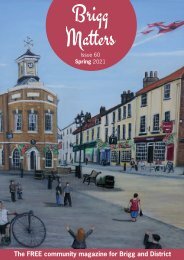Brigg Matters Issue 61 Summer 2021
Brigg Matters Magazine Issue 61 Summer 2021
Brigg Matters Magazine
Issue 61 Summer 2021
Create successful ePaper yourself
Turn your PDF publications into a flip-book with our unique Google optimized e-Paper software.
daughters married, Master<br />
Mariners.<br />
On gaining his Master’s<br />
Certificate in 1853,<br />
Charles immediately<br />
became Mate on the SS<br />
Great Britain which, after<br />
a troubled decade since<br />
her launch, had just been<br />
refitted in order to take<br />
emigrants to Australia as<br />
a consequence of the gold<br />
rushes there. She was the<br />
Concorde of her day, using<br />
a combination of steam and<br />
sail power to take up to<br />
700 passengers in varying<br />
degrees of comfort at record<br />
speeds because she could<br />
continue under steam in<br />
light winds.<br />
Charles served under<br />
Captain Gray for much<br />
of his time on the Great<br />
Britain, completing 14<br />
return voyages in total,<br />
the last three as Captain<br />
following the disappearance<br />
overboard and presumed<br />
suicide of Gray.<br />
You would expect a<br />
Master Mariner’s life to be<br />
adventurous, and Charles’<br />
does not disappoint. One<br />
of the (literally) tall tales he<br />
told Mother Mary at dinner<br />
concerned being taken by<br />
the King of the Friendly<br />
Islands (Tonga) to the palace<br />
to meet the Queen who, towering above his 5’9” frame,<br />
caused him to climb on a chair in order to perform the<br />
traditional greeting!<br />
The Great Britain was refitted twice and, with Chapman<br />
as Officer, took British troops to overseas conflicts, firstly<br />
in 1855—as reported in the Stamford Mercury—to the<br />
Crimean War, and in 1857 to the Indian Uprisings.<br />
Shortly after this Chapman was given his own command,<br />
the Thetis, built in Canada. It briefly held the Blue<br />
Riband for the fastest crossing of the North Atlantic but<br />
in 1866 it was shipwrecked on an unmarked island in<br />
Isambard Kingdom Brunel with the chains of the SS Great Britain<br />
the Pacific. Chapman took six of his crew in a longboat<br />
to try to get help but it was a month before they were<br />
rescued and longer still before help could be sent for the<br />
remaining 26 crew members. We wonder whether his<br />
family knew anything until his safe return.<br />
Chapman was only to make three return trips to Australia<br />
as Captain of the Great Britain. It is understood that on<br />
his way to rejoin SS Great Britain, in dock in Liverpool,<br />
he fell from a horse-drawn tram creating the medical<br />
condition from which he later died in 1875 aged 53.<br />
Although still a relatively young man, he had lived a life<br />
few of us could match.<br />
This year marks the<br />
200th anniversary of<br />
his birth and, but for<br />
the pandemic, it would<br />
have been celebrated it<br />
in style this <strong>Summer</strong> on<br />
board the wonderfullyrenovated<br />
Great Britain<br />
moored in its original<br />
dry dock in Bristol and<br />
attended by over 100<br />
descendants from all over<br />
the world.<br />
At the time of writing<br />
no known descendants<br />
are living in the <strong>Brigg</strong><br />
or North Lincolnshire<br />
area. It would be so<br />
appropriate should any<br />
be found as Rick and<br />
his wife are intending<br />
to revisit <strong>Brigg</strong> and<br />
Broughton in the near<br />
future to continue<br />
their research into the<br />
Chapman family.<br />
Poster for SS<br />
Great Britain<br />
The SS Great Britain was the first iron-hulled ship designed as a passenger ocean-going vessel to be fitted with<br />
the revolutionary screw propeller. Designed and constructed in Bristol by the famous Victorian civil/maritime<br />
engineer, Isambard Kingdom Brunel, she was launched in 1843 with her maiden voyage in 1845. She was,<br />
until 1854 the world’s largest passenger ship.<br />
Initially proposed for transatlantic routes, for which she gained the record of the fastest crossing of 13½ days, SS<br />
Great Britain was re-designated to the Far East and Australia routes.<br />
She had an illustrious but varied career, refitted from a 350- to over 700-passenger liner; officially sold for scrap,<br />
but brought back into service; used as a troop-carrier and, in later life, becoming a store ship and a static coal<br />
bunker in the Falkland Islands. In this latter role she fuelled the Royal Navy’s Southern Atlantic fleet during WW1<br />
and part of the metal structure was used to repair HMS Exeter, severely damaged during its skirmish with the<br />
German ship Admiral Graf Spee during the Battle of the River Plate in WW2 (December 1939).<br />
In 1970 the SS Great Britain’s abandoned hulk was recovered and brought back to Bristol where it now forms<br />
the city’s number 1 tourist attraction as one of this country’s National Heritage Fleet.<br />
24<br />
<strong>Brigg</strong> <strong>Matters</strong><br />
<strong>Brigg</strong> <strong>Matters</strong> 25

















